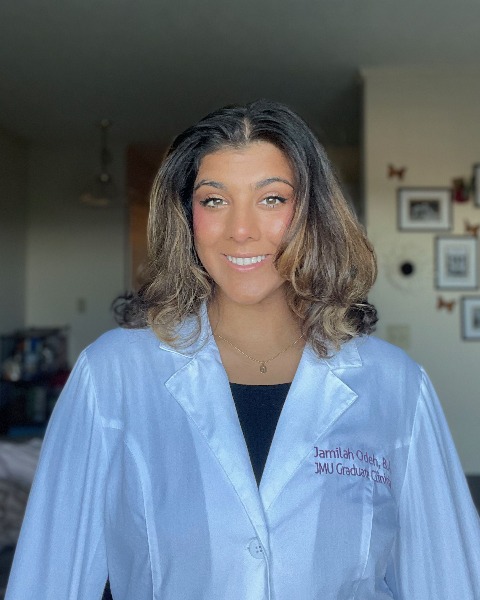Research (R)
PP1323 - Neuraudiversity: Assessing ADHD Through Speech-on-Speech Masking in Soundfield

Becky Hales, BS (she/her/hers)
James Madison University
Financial Disclosures: I do not have any relevant financial relationships with anything to disclose.
Non-Financial Disclosures: I do not have any relevant non-financial relationships with anything to disclose.- KH
Kate Hobbs
Financial Disclosures: I do not have any relevant financial relationships with anything to disclose.
Non-Financial Disclosures: I do not have any relevant non-financial relationships with anything to disclose. 
Jamilah Odeh, BA (she/her/hers)
James Madison University, Virginia
Financial Disclosures: I do not have any relevant financial relationships with anything to disclose.
Non-Financial Disclosures: I do not have any relevant non-financial relationships with anything to disclose.
Lincoln Gray, PhD
Research Advisor
James Madison University, VirginiaFinancial Disclosures: I do not have any relevant financial relationships with anything to disclose.
Non-Financial Disclosures: I do not have any relevant non-financial relationships with anything to disclose.
Lead Presenter(s)
Contributor(s)
Summary:
The DSM-V criteria for ADHD includes “does not seem to listen when spoken to directly”, “fails to follow through on tasks and instructions”, and “difficulty sustaining attention”. Given that we diagnose APD, and there is a strong correlation of symptoms between APD and ADHD, perhaps we could quantify the manifestation of auditory symptoms to be able to partner with psychologists in diagnosing this condition.
We developed a novel speech-on-speech informational masking task in which participants are surrounded by eight speakers with a computer in front of them. They are instructed to listen for a keyword and then follow the instructions to click the correct button on the computer screen. Simultaneously a distractor plays from a separate speaker, giving a different keyword and set of instructions. Two trials were presented to the participants, one where the stimulus and distractor were stationary, and one where they bounced semi-randomly around the array of eight speakers. An adaptive procedure was used to find the signal to noise ratio for each individual. Ultimately the test takes less than 10 minutes to complete and was administered to college-aged participants with normal hearing, some with ADHD and neurotypical controls.
We looked at several variables, with the hypothesis being that some correlative patterns would emerge between the two groups. Using a Pearson correlation test, we found two major patterns. Firstly, the ADHD group had significantly worse SNR-C scores. SNR-C refers to the fact that the test was a closed-set, forced-choice task. Compared to the QuickSIN or other open-ended speech in noise tests, participants did not have the option to say “I don’t know” or to choose something that was not on the computer screen, so even the worst SNRs on this task would look phenomenal compared to the SNR that would be achieved on a QuickSIN. For this reason, we are referring to the scores as SNR-C to avoid confusion or comparison to other results.
The second significant finding was that individuals with ADHD have greater variability between the two tasks. The neurotypical group had almost no variability in their performance when the stimuli and distractor were stationary compared to when they were randomly presented, but this change made a significant impact on the performance of the individuals with ADHD.
This preliminary testing and data seem to indicate that we can quantify auditory distractibility in a way that could aid in the diagnosis of ADHD as well as justify the use of auditory-based accommodations such as FM systems. If subsequent trials and research continue to show these patterns, we have the potential to expand our scope of practice and build more inter-professional relationships.
Learning Objectives:
- Analyze the auditory symptoms of ADHD and interpret SNR and variability results from a novel test in order to quantify distractability.
